Information about the island of Limnos Greece

The whole island has been affected by the existence of the ancient volcano that has been inactive for centuries. But it has contributed to the creation of various geological phenomena and has influenced the natural landscape in an impressive way.
With a strong presence in Greek mythology, it is the homeland of the god Hephaestus, while Homer in his epics has sung about the island and all that it has to offer, since ancient times.
Lemnos is almost flat and does not have large mountains but there are natural rock formations in Faraklos. The waterfalls in Kaspakas and the sand dunes, are among the natural attractions of Lemnos that the visitor should not miss. Lagoons and important habitats host thousands of birds during their migration season.

Lemnos has many churches and chapels but the one that impresses the most is the chapel of Panagia Kakkaviotissa which is covered by rocks instead of a roof.
All the villages of Lemnos retain their picturesqueness with traditional houses and each with its own attractions. Myrina which is the capital of the island is famous for its castle but also one of the most beautiful island cities in Greece.
Mythology and History

In addition, we are informed that in honor of Hephaestus they built the first city of Lemnos, Hephaistia, and also established the Hephaestian games.
According to Aeschylus, the temple of Hephaestia on Lemnos is the first point from which fire came out and was given to man, by the Titan Prometheus. Because of this gift to the people of Lemnos, Zeus punished the demigod Prometheus, binding him with thick chains on his hands and feet in the mountain Caucasus.
However, from the various findings of the excavations in Poliochni, it appears that Lemnos began to be inhabited from the fourth millennium before Christ, but no evidence of its first inhabitants has been identified. From 4000 BC until the appearance of the Sindians, the inhabitants of Lemnos are unknown. It is the period when Poliochni (4000-1600 BC) developed an important culture, but also perhaps the sunken city of Chrysis, for which there is no evidence of development and culture until today.
Myrina the capital of Limnos
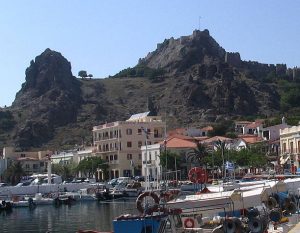
In the middle rises the steep rock with the castle on top and around the town, with the mansions and the neoclassical houses. The castle may not be the most well-preserved in Greece, but it has something very special.
Around it live beautiful fawns (platoons), which were brought in the 70s from Rhodes, and today, because the residents love and care for them, they have increased.
It is worth visiting the Metropolis of the Holy Trinity with its ornate marble bell towers, the Archaeological Museum, the Karatzadeo Library and the Folklore Museum.
You will swim in the crystal clear waters of Myrina, Pomaiikos Gialos, Picha Nera where there is also a beach bar, in Gialos of Limaniou, while a little further (you can also go on foot) you will find the beaches of Avlona, Platiou, a village with traditional houses and old stone fountains, and Thanos with its picturesque taverns.
Water bikes and canoes are available for rent on the beaches of Pomaiikos Gialos and Pihon Nera. In the area of Therma, 4 km from Myrina, there are thermal springs/
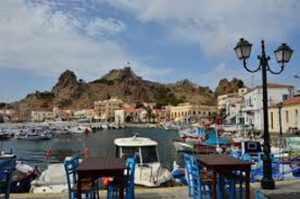
In eastern Lemnos you can go surfing and kite surfing, while at Keros beach in recent years they even offer organized lessons. Fishing, walking, cycling and festivals are among the must-do activities.
In summer, don’t miss the events and theater performances organized by the People’s Stage of the Educational, Cultural and Sports Association of Lemnos. Cultural events are also organized by the Municipality of Myrina, the first fortnight of August. Feasts are held on July 27th of Agios Panteleimon and Panagia on August 15th.
Limnos has a long tradition of local products which are of high quality and very tasty. The most well-known are mainly dairy products such as “melichloro”, “kaskavali” and “kalathaki”. Lemnos also has wonderful honey and grains, such as nuts, wheat flour and flomaria.
You will taste a wide variety of the island’s wines with a special taste due to its volcanic soil, but also traditional sweets, such as “venizelika”, which got their name from the fact that El. Venizelos who tried them during his visit to Lemnos after the liberation of the island.

Moudros

The bay of Moudros, protected from the north winds and from the currents of the Dardanelles, is navigable even by large battleships. This alone gives it great strategic importance. During the Balkan wars it was a stronghold of Pavlos Kountouriotis – his donation is the Epitaph of Evangelistria.
Near the village there is a petrified forest, but its area is not yet open to visitors.
It is worth visiting the church of the Annunciation of the Theotokos which was built in 1904, but also of the Taxiarches which was probably built in 1370.
You will swim at the beach of Agios Pavlos, in Fanaraki (4 km from the village), and at Xavouli beach, with its wonderful sandy beaches.
There are hotels and rooms for rent, most facing the sea.

Plaka
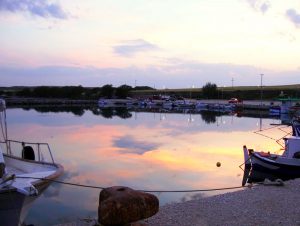
The settlement of Plaka, which was established in the middle of the 19th century, preserves in most parts of the village the traditional architecture with stone-built houses and stone-built cobblestone streets.
The view from this point to Imbro, which is only 12 nautical miles away, is magnificent, which made the expelled Imbros designate Plaka for their annual meeting, in the chapel of Agia Anna, a meeting founded by the Ecumenical Patriarch Bartholomew.
Visit the central church of Plaka, dedicated to Agios Dimitrios, where the wood-carved iconostasis stands out, baroque style and the oldest of the church, as it dates from the end of the 18th century and is believed to come from a monastery in neighboring Lesbos.
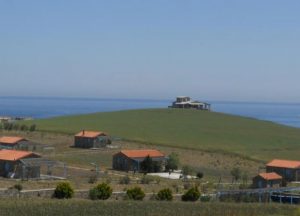
In addition, the old port of Plaka is dominated by Vriokastro or Paleokastro, a medieval fortress.
You will swim at the beaches of Agios Stefanos and Mandri. Near the beach of Agios Charalambos, there are thermal baths, ideal for rheumatism and mud therapy with “lake earth”, one of the most important medicines of Hippocrates. A festival takes place on August 6, the feast of the Savior, and on August 23, the feast of Panagia.

Things to do in Limnos

Set aside a few hours to get to know the island’s west coast capital Myrina which remains mercifully unscathed by the ravages of mass tourism. This port town offers a collection of cobbled streets, old-fashioned and very “Greek” kafeneia, imposing Ottoman mansions and 19th century houses with overhanging wooden balconies. The main shopping street is lined with interesting shops offering local produce such as honey, nuts and island wine. And above it all looms a crumbling Byzantine castle.
Visit the town’s archaeological museum to see finds from the three excavated sites at the eastern end of the island. The museum is housed in a neoclassical mansion overlooking the beach next to Hotel Castor. Sadly, many of the most interesting items have been claimed by Athens but the collection is still worth viewing and benefits from good presentation and labeling (which is far from being the case in many Greek museums).
Exhibits include pottery from Poliochni, a fortified town founded around 3,000 BC and razed to the ground by an earthquake 900 years later. Gold jewellery and bronze household items from the site of Hephaistia are also on display. Hephaistia was once the most important city on the island, dedicated to Hephaistos – the god of fire and metalworking who was reputedly hurled over to the island from Mount Olympus by an irate Zeus. Votive lamps fashioned as sirens are the star exhibits among the finds excavated at the site.
Take a trip up to the ruined castle on the headland because although it’s in a poor state of repair the views all the way over to Mount Athos on the Greek mainland are magnificent. The Byzantine ruins stand on the site of a 7th century BC fortress – wear sturdy shoes to explore the site and look out for the deer which are the only occupants these days.
Having visited the archaeological museum you may want to make the trip out to the east of the island to see the three ancient sites where excavations are still ongoing. The ruins at Poliochni are hard to make out for non-specialists so take a brochure from the museum with you. If you’re lucky the Italian excavators may be on site and willing to give you a guided tour.
The sites of Hephaistia and Kabireio, on opposite shores of Tigani Bay in the north east corner of the island, are also difficult to make sense of unless you’re an archaeologist but if you swat up on their history you’re bound to be moved by these evocative ancient ruins. Below the Kabeirio site you can visit the sea grotto known as the Spilia tou Filoktiti (Cave of Philoctetes). This is where the warrior Philoctetes, a hero of the Trojan War, allegedly took refuge while waiting for his gangrenous, snake-bitten leg to heal.
If you’re running short of sights to see on Limnos, take a day trip from Myrina to the little known island of Agios Efstratios – one of the loneliest and remote spots in the Aegean. The island offers traffic-free tranquility, deserted beaches and a traditional way of life untouched by tourism.
What to see
The island of Lemnos fascinates with its unique landscapes with volcanic rocks, fertile plains, sand dunes and impressive architecture and will not leave even the most demanding visitor unmoved.
Poliochni
It is the first organized city in Europe. It developed and flourished from the Neolithic period, the 4th or 5th millennium BC. to 1,600 BC about. For 2,000 years the city flourished and the treasure of gold jewelry, found inside a buried vase, is a sample of power, wealth, fine taste and sophisticated technical knowledge.
Today it is kept in the National Archaeological Museum of Athens and has many elements in common with the famous “Treasure of Priam” found in Troy by Erik Schliemann. Also, one of the most distinctive items of Poliochni are the clay cups with a tall cylindrical body and two curved handles, of the “depas amphikipellon” type, a typical type of cup of Troy.
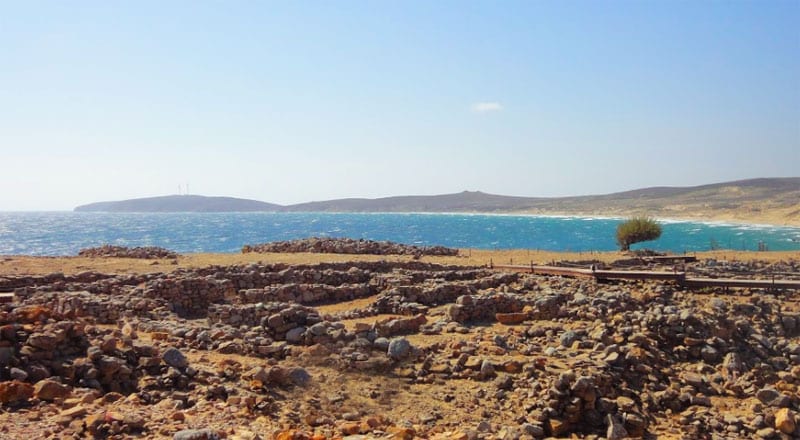
Hephaestia
The city dedicated to Hephaestus, was in ancient times, the second most important city of the island along with Myrina. Two ceramic kilns were found near the sanctuary, testifying to the existence of a pottery workshop, a reminder of how long the pottery tradition is on the island. The ruins of a complex city covering an area of approximately 10 acres are preserved, which included splendid buildings, palaces, baths and Christian churches, a Hellenistic-Roman theater and a Sanctuary of the 8th to 6th BC. h. dedicated to the great Goddess Lemnos, identified with the Goddess Artemis. In the adjoining rooms of the Sanctuary, unique works of art were found, such as a whole series of clay statues representing Sirens and Sphinxes. The necropolis of Hephaestia was discovered there with findings and three other cemeteries from later years.

Sanctuary of Artemis
The goddess Artemis was the patron goddess of the city of Myrina. The inhabitants built a temple in her honor, at the point where, according to legend, a huge goat appeared to hikers at dusk. At the north-west end of the enclosure, a rectangular room was identified which included desks and looked like a meeting place. Probably the place is connected with the initiation ceremonies of the believers. The finds from the excavation site are exhibited at the Archaeological Museum of Myrina. Among the exhibits, the skeleton of a sacrificed bull impresses.

Cave of Philoctetes
It is located below one of the most important archaeological sites of Lemnos, Kaverio, in the north-eastern part of the island. Philoctetes stayed there when his fellow Achaeans abandoned him on their campaign to Troy because he had been injured by a snake bite. In fact, according to mythology, Philoctetes lived in the cave for 12 whole years and was cured using the healing lake Earth. Philoctetes was a source of inspiration for our three tragic poets, with Sophocles’ work surviving in its entirety to this day.

Myrina Castle
The Fortress is built on a steep peninsula, above Myrina, the capital of Lemnos, and communicates with the land only from the east. It is the largest castle in the Aegean. It was built by the Venetians preserving parts of an earlier phase of the Byzantine period. The current structure and layout is due to the Genoese Gattilusi who remodeled it (15th century) as well as to the later Venetian and Turkish interventions.

Faraklo
It is a unique geological monument with volcanic formations with strange formations that impress. It is said that this is lava that came into contact with water and froze, forming these strange molds, but it is more likely that it is sandstone, that is, sedimentary rocks. You’ll also hear the locals call it Falakro or ‘pig-headed’, as the geological formations are often spherical in shape.

Sand dunes
In Lemnos, the strong northerly winds constantly reshape these sand hills, resulting in an unusual visual spectacle against the deep blue sea! They are included in the natural habitats and offer a special spectacle. You will find sand dunes in several parts of the island, with the most impressive being located in the northwestern part of Lemnos, in the Gomati area, and covering an area of 70 acres. This region justifies its characterization as the “Sahara of Europe”.
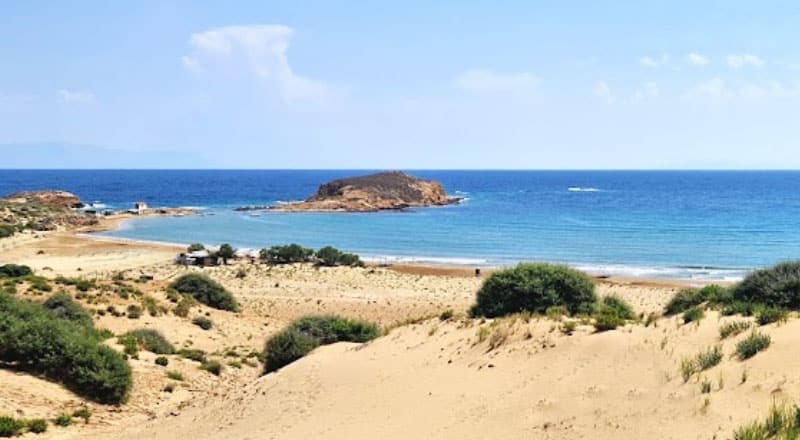
Hortarolimni
It is a brackish lake, in the eastern part of the island. Together with Aliki and Asprolimni, it forms one of the most important wetlands of the entire northeastern Aegean. It has an area of 2,300 acres. In the summer it dries up, leaving a thick layer of salt on its surface.

Folklore Museum
It dominates the village of Portianou and includes exhibits from the daily life of Limni. Exhibits presented with special taste in a two-story traditional house.

It is located near the village of Zemata, in the Thanos region, 4 km southeast of Myrina. It has been known since 1305, the year it became the property of the Megisti Lavra monastery. Impressive is its location in a hard-to-reach cave, at the top of Mount Kakavos, among imposing rocks!

Beaches

In the bay of Bournia one can enjoy the shallow waters of the beach of Kotsina. It is the busiest beach in the area. Riha Nera is the most secular beach of Myrina and is located near the Roman Glass. Finally, other beaches are Avlonas, Nevgatis, Havouli, Skidi and Sarpioskala.
Local food and Gastronomy
Lemnos, thanks to its area and geographical relief, has developed primary production since ancient times. Their products are produced on the island, such as traditional pasta, cheeses, sweets, alipasta, wines, crab meat, legumes, flour, nuts, herbs, olive oil, honey and more.
Lemnos wheat has been famous since ancient times, as well as the “Lemnos Basket” made from goat’s and sheep’s milk and the melichloro (or melipasto) cheese.
The cultivation of wine is also extensive. The red “Limnio” or “Kalampaki” as it is called locally and the Muscat of Alexandria are two of the most popular wine varieties of the island. Finally, legumes such as broad beans (fava beans), beans (black and white) and chickpeas are produced.
Tradion and culture
Festivals
There are many festivals in honor of the Saints of the Orthodox Church on the island, such as the festival of Panagia in many areas of the island on the fifteenth of August, the festival of Panagia Kakkaviotissa on Easter Tuesday, the festival of Agios Sozontas on September 6, the eve of the feast , in Skandali which is also the patron saint of the island and the festival of Agios Panteleimon (Androni – Myrina area) on the eve of the 26th July holiday. But most famous of all is the festival of Agios Georgios on April 23 in Kalliopi where a large number of people gather. Every year, since the time of the Turkish rule, on St. George’s Day, horse races are held and the first three riders with their horses are awarded, in the courtyard of the Holy Church of St. George of Kalliopi.
Gastronomy and Wine Festival
In July every year since 2017, the Gastronomy and Wine Festival “Lemnos Philema” takes place by the Gastronomy & Wine Association of Lemnos, with many well-known guests, highlighting the local gastronomy of Lemnos in an interactive and authentic way, that of hospitality and film. Lemnos Philema aims to holistically present the gastronomy of Lemnos by creating a culinary community with producers and restaurants of the island.
Horse racing
The custom is held in honor of Saint George in the village of Kalliopi. During the Turkish rule, two groups participated in the horse races, one Muslim and one Christian, which shows that the Turks also respected the custom and honored the saint along with the Greeks. The first three riders with their horses are awarded by the vicar of the Holy Church of Agios Georgios Kalliopis in the forecourt of the church
Kakanoures
On June 23, the eve of the feast of St John, a custom known as kakanoures is celebrated in Lemnos. After the residents gather in an open space or in the village squares, they light fires of straw and wreaths they have made since May Day and jump over them three times – a symbolic number for Christians. According to tradition, fire brings about purification and people are freed from evil.
Τhe Batatsoudes
On Epiphany day, the men in the villages revive the ancient custom of Batatsoudes, mainly in the village of Kaminia. On the eve of the Festival of Lights , as soon as the sun reigns, men, after disguising themselves as animals, form groups and go out into the village. They wear animal skins and bells and try to ward off evil spirits. Their purpose is to scare small children.
The Batatsoudes (goblins) visit the houses and ask the housewives: “Are the children crying” or “are they eating the fagit’s” or “a grumbler”. If the children haven’t managed to hide, the Batatsoudes hit their sticks, their bells and bully the children saying “I’ll get you”. Mothers throughout the year threaten the children if they are mischievous: “You will let the Bandatjudes take you.” As a treat, the housewives gave the Batatzoudes marbles, eggs, wine, almonds, meat, fruit, etc. With these foods, on the day of the Lights, a great festival was held in the village square in the evening.
How to get to Limnos
To get to Lemnos, you primarily have two optionsby air or by sea.
By Air
Lemnos has an airport (Myrina Airport (LXS)) near the capital, Myrina. There are domestic flights that connect Lemnos with Athens and sometimes with Thessaloniki. The frequency of flights can vary, with more frequent connections during the tourist season. During the peak tourist season, there might be charter flights from certain European cities directly to Lemnos. However, these are not as common as domestic flights.
By Sea
Ferries connect Lemnos with other Aegean islands and the Greek mainland. The most common connections are with Piraeus (the port of Athens), Kavala, and Thessaloniki. The duration of the ferry trip depends on the route and type of ferry. For example, the journey from Piraeus might take around 10 hours or more, while the journey from Kavala is shorter, around 4-5 hours. Ferry schedules can be seasonal, with more frequent connections during the summer months.
Limnos Airport
Lιmnos International Airport is located 18 km from the town of Myrina and began operating in the late 1950s. The airport is managed by the Hellenic Civil Aviation Authority, which is responsible for overseeing Greek airspace.
Depending on the year and the summer season, Lemnos Airport is connected to a wide network of mainland and island destinations, including Lesvos, Chios, Ikaria, Rhodes, Samos, and Crete.
All these routes, which often change, should be checked directly on the websites of the airlines that operate them, Sky Express and Olympic/Aegean.
An Olympic Airways bus service connects the capital of Lιmnos with the airport. Lemnos has air connections with Athens, Thessaloniki, and Lesvos. The offices of Olympic Airways are located in Myrina.
Facts about Limnos
| Information | Tourist information |
|---|---|
| Size: 476 sq. km | International code: 0030 |
| Population: about 16 000 | Local code: 22540 |
| Banks Cashmachines: Yes | Hospital: 22222. 23333 |
| Internet cafe: Yes | Port Police: 22823 |
| Highest Mountain: Skopia 470m | Police: 22200 |
| Airport: Yes | Tourist Office: |
| Tour Operators: | Airport: 29428 |
| Hotel Association: | Tourist Police: 22221 |
| Fire Brigade: 22199 |
